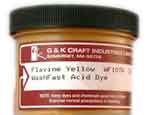ADVERTISEMENTS

Karren Brito's
Shibori: Creating Color and Texture on Silk
This book describes the use of Washfast Acid Dyes and Lanaset Dyes to dye silk using ancient Japanese Shibori tying techniques.
ADVERTISEMENTS

ADVERTISEMENTS




Since silk can be dyed with almost any sort of dye, you need to decide which properties are most valuable for you in your current project. Are you most concerned that the dye be completely non-toxic for small children, or that it be particularly easy to apply, or that the dyeing process not alter the texture or luster of your silk even a little?
Non-toxic. Most of the dyes mentioned on this web site are not significantly toxic, but they are not safe to eat, either. If you want to use a dye that's safe to use your good (non-aluminum) cooking pots for, and still be able to use your dye-pots for food, then you should use food coloring. Food coloring is not the brightest, most predictable, wash-resistant, or fade-resistant of dyes. However, it is safe to use in your good cooking pots, and it is safe to use with small children, children who are too young to follow standard safety practices. If you'd like to use food coloring to dye silk, see the page Using Food Coloring as a Textile Dye for Protein Fibers.
Many people imagine that natural dyes are the safest type of dyes to use, but in fact natural dyes can bring their own hazards; natural dyes are usually less safe to handle than food coloring, as textile dyes, and most are less suitable for dyeing baby items than fiber reactive dyes.
No heating and no steaming. If your primary concern is to avoid investing right now in a dyepot, or to avoid bothering with simmering or steaming your dyes, then you should use a cool-water fiber reactive dye, such as Procion MX type dye. You can dye any washable silk with the same soda ash recipe we use for dyeing cotton with Procion MX dyes. It's perfect for tie dyeing, batik, low water immersion dyeing, dye painting, or any other form of direct dye application. It can also be used to dye silk in the washing machine. The only drawback is that the soda ash will make the silk a little less shiny and a little softer; sometimes this is desirable, but if your number one priority is to maintain the stiff texture and shiny luster of your silk, then you should use some sort of acid dyes, instead, although they will require some heating.
Alternatively, there is a way to fix Jacquard Green Label Silk colors at room temperature without the use of a high pH; these dyes are mixed to have an acidic (low) pH, although they are Remazol fiber reactive dyes.
A third alternative, if you do not want to steam your silk, is to use fabric paints or even fabric markers, instead of true dyes.
Wash-proofness. The best dyes for staying bright even after washing are the cold-water fiber reactive dyes, such as Procion MX, when used with soda ash, and the Lanaset dyes when used as directed. The metal complex dyes, such as KraftKolour's Premetallised Acid Dyes, are also very good. (In fact, some of the Lanaset dyes are metal complex dyes.) If you want an extremely long-lasting, wash-proof dye that does not make your silk a little softer, use Lanaset or metal complex dyes, both of which must be used either in a boiling dyebath or with steam-setting afterwards.
Good for silk painting. Any of the dyes mentioned above, with the exception of the food colorings, are good for silk painting, but you will have to mix your own colors. Procion MX dyes should be used within a week of mixing, but the other dyes stay good in water for up to a year, or in some cases longer.
The silk dyes known collectively as the French Dyes are available pre-mixed in a wide variety of colors in small jars. They are known for their brilliant colors as compared to the pigment-based fabric paints that are used in silk painting. Some of the colors are basic dyes (with poor lightfastness), some are reactive dyes, some are acid dyes, and some are metal complex acid dyes. The different brands of the French dyes include Dupont, Pebeo Soie, Sennelier Tinfix, and Kniazeff. They require lengthy steaming to fix them, three hours instead of the thirty minutes required for Remazol and Procion H dyes.
The Remazol dyes are very cost-effective when used as silk paints; you can set them after they dry by steaming the silk for half an hour. Both Remazol and Procion H dyes are considered to be less toxic alternatives to the French dyes, though it is impossible to do a direct comparison since in most cases there is no way to find out which dyes are included in the French silk dyes.
True colors. The dyes that are mixed for use on cotton will in many cases produce unexpectedly different colors on silk, because the dyes in the mixture may each work a little better or worse on silk than on cotton. Mixtures of Procion MX dye colors are the worst for color predictability when used with soda ash, but more predictable when used as acid dyes, with citric acid or vinegar instead of soda ash, though the pure unmixed colors of Procion MX will produce very nearly the same color on every fiber. The best dye choices for absolutely predictable colors on silk are the Lanaset dyes, the acid dyes, and the French silk painting dyes such as Tinfix, Pebeo Soie, and Dupont. My own favorite black dye for silk is the Lanaset Jet Black, which is a very rich deep black that is highly wash-resistant.
Once you've chosen your silk dye, you must acquire any necessary auxiliary chemicals, and decide on your method of dye application.
The auxiliary chemicals required vary according to the specific dye and application method you choose. Look at the instructions provided by the manufacturer of your dye, or look among the comprehensive collection of many specific recipes provided on the web site of Pro Chemical & Dye for different dyes. Commonly used auxiliaries for different dyes include soda ash (sodium carbonate), baking soda (sodium bicarbonate), urea as a humectant, acids such as citric acid, acetic acid, vinegar, or sodium bisulfate, sodium acetate, Albegal SET for Lanaset dyes, Synthrapol detergent, Ludigol ('chem flakes') to prevent reduction of reactive dyes during steaming, the water softener sodium hexametaphosphate, alum as a mordant for natural dyes, sodium alginate or print paste, and salt for high water immersion dyeing with reactive dyes or direct dyes.
Solid colors. As with any fiber, for smooth, even solid colors, you need to immerse the silk fabric or yarn in a dyebath that is large enough for it to move freely. Cool water dyes, such as Procion MX, may be applied to silk fabric in a bucket or in a washing machine (preferably a top loader). Acid dyes may in some cases also be applied in the washing machine; though the 140° or lower water temperatures in a washing machine are far from ideal for setting acid dyes, the great convenience of the method ensures its popularity. Acid dyes and hot water fiber reactive dyes should be applied in a very large non-aluminum cooking pot, large enough for the silk to move in freely. Be careful not to subject your silk to excessive heat; instead of boiling your dyebath, take care to maintain its temperature at or below 185°F or 85°C, to prevent damaging the silk.
Low water immersion. If you use a cool water fiber reactive dye such as Procion MX, closely follow the instructions on the "How to Do Low Water immersion Dyeing" page. If you use a hot water dye, such as acid dyes, substitute an acid, such as vinegar or citric acid, for the soda ash, then place the uncovered container you've chosen for your LWI inside a large pot of water, and simmer or steam to heat set the dye.
Tie-dyeing. Tie dyeing silk is easiest using the same recipe as for cotton for a cool water fiber reactive dye, such as Procion MX, along with soda ash. The usual method is to dampen the fabric in plain water, tie it in different ways to produce patterns, presoak the fabric in a mixture of soda ash and water, then squirt on the dye and allow the dye to react overnight in a warm place. To tie-dye with acid dyes or hot-water reactive dyes, apply the dye as for tie-dyeing, allow to dry completely, and steam-fix the dyes as described below.
Painting. The "French" silk painting dyes, such as Tinfix or Dupont, are ready to go out of the jar. Depending on your painting techniques, other dyes which you mix yourself may need to be thickened with sodium alginate, or a mixture including this thickener such as Print Paste SH (for thicker fabrics) or Print Paste F (for most silks). Typically a mixture of sodium bicarbonate with sodium carbonate is used for painting with reactive dyes; bicarbonate converts to carbonate during the steaming process.
Detailed painting works best if you stretch your silk out tightly first. For simple painting, you may find it sufficient to tape the silk to a plastic board or tabletop, but heavy applications of paint are apt to puddle and accumulate under the fabric, muddling your design. You can stretch your fabric using commercial silk painting stretchers; check with your dye supplier, as both ProChem and Dharma carry Arty's Easy Fix Fabric Frames, which I like very much. Another method I've used is to attach clips or hooks the the edges of the silk on rubber bands stretched within a frame constructed of the wooden bars oil painters use to stretch their canvases on. Unless you have a margin of fabric that will not be displayed, be careful not to let your silk touch the wood, because it will hold dye that will transfer to your next piece.
Resists. A resist is any method of creating designs by preventing the dye from accessing all of your material evenly. Shibori and other forms of tie-dyeing use various ways to bind with ties or sewing with thread as a resist. The very popular silk painting method known as the Serti technique involves painting outlines onto fabric, using a resist material such as gutta (rubber dissolved in solvents), wax, fabric paint, or water-soluble resists, then filling in the spaces between the lines with unthickened silk dye or thin silk paint. Water-soluble resists should not be used for immersion dyeing, nor for tie-dyeing that involves presoaking in soda ash or flooding with large amounts of dye; for these methods of dyeing, non-water-soluble resists such as tying, wax, or gutta are required.
High pH for reactive dyes. Cool water reactive dyes such as Procion MX dye can be fixed at room temperature, without steaming, with any of several high pH chemicals. You can pre-soak the silk in soda ash before painting (optionally letting it line-dry), or add the soda ash to the dye immediately before use, or paint on a sodium silicate (After-Fix) solution afterwards. See What is soda ash, and what's it for in dyeing? for more information on soda ash and its substitutes.
Steaming is used to fix all acid dyes on silk, and also to fix hot water fiber reactive dyes such as Procion H, Remazol, and Drimarene X. In most cases, the dyed fabric is allowed to dry, then wrapped in layers of blank newsprint paper for steaming. A few recipes call for wrapping the dyed material in plastic wrap, but in these cases the fabric must be quite wet, because moisture is essential for either acid dyes or reactive dyes to bond to the fiber. True dyes cannot bond to silk without the presence of water in one form or another.
Note that steam cleaners, steam irons, and clothing steamers do not produce enough steam to set silk dyes.
Fixing Silk Dye in Hot Water. Hot water dyes, including both acid dyes and hot water fiber reactive dyes, can, instead of steaming, be applied by immersing the fiber to be dyed in a hot dyebath, usually for half an hour or an hour, along with any required auxiliary chemicals. The required temperature and timing will vary according to the specific type of dye.
Using Fixatives Instead of Heat. There are some chemical fixatives which can be used for acid dyes instead of steaming. The colors are likely to be less intense without steaming, but the method is convenient, especially for use in the classroom. (An equally valid approach, when steaming is impractical, is to use fabric paints instead of dyes.)
Jacquard's Green Label Silk Colors are Remazol dyes with added chemicals to make them suitable for fixing with Jacquard's Permanent Dyeset Concentrate, which is applied after the dyes are painted on. There used to be a similar product for acid dyes, called Tinfix Design Dye Fixative, but I can't find a source for it now. Dharma Trading Company advises that Jacquard's Permanent Dyeset Concentrate can be used with Tinfix dyes, though, they note, the colors will not be as brilliant as steam-set Tinfix dyes.
Other products that are called dye fixatives, such as Retayne, Dharma Dye Fixative, and iDye Fixative, are not suitable for use as an alternative for steam-setting dyes; these cationic dye fixatives are an entirely different sort of product, to be used only on dyes that have been properly set and yet which still lack adequate washfastness, such as direct dyes, all-purpose dyes, and acid leveling dyes.
Silk garments will last longest if cleaned by hand washing in cool water, or by dry-cleaning. You may launder many silks in a washing machine with cool water on a delicate setting, but never throw your silks into the same washing machine load as heavy garments such as jeans.
Silk that has been dyed with Procion MX dyes using the soda ash recipe can be washed at any temperature without risk of running or bleeding dye, assuming that excess unattached dye was washed out after dyeing. Silk that has been dyed with Lanaset dyes, including some metal complex dyes in that line, is similarly washfast, and can be washed even in hot water, up to 140°F (60°C), without loss of dye. With these highly washfast dyes, the only limiting factor is the need to treat the silk gently enough that it does not wear out quickly.
However, silk that has been dyed with less washfast dyes, particularly acid leveling dyes and, especially, food coloring, should be carefully washed separately, in cool water only, to avoid causing the dyes to wash out. Silk dyed with food coloring should be washed as infrequently as possible, as the dye tends to wash out over time.
Many silk painters mark their work "dry clean only", to encourage the dye colors to stay bright as long as possible, and reduce wear on the material itself.
If at all possible, store dyed and painted silk out of direct sunlight or bright light. All dyes can be damaged by exposure to sun, and the French dyes used for silk painting have a particular reputation for poor lightfastness.
All of the pages on this site are copyright ©1998‑2026 Paula E. Burch, Ph.D.
Last updated: July 28, 2011
Page created: October 30, 2009
Downloaded: Tuesday, January 06, 2026
A small portion of the material ion this page originally appeared on another page on this site, Dyes for Protein Fibers, which was first created on May 5, 2003.